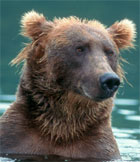
Source of Image
Notes for Chapter 30: Mammals
Click link to return to Lecture
Schedule
or back to Chapter 28
Chapter 30 Assignment:
609-621, 624-626, 634-639;
RQ-30: 1-2, 6-8, 11, 15-16 (last two lectures)
Introduction: The Tell-Tale Hair
Featured Animal: Grizzly
Bear
More Links: 1
- 2 - 3
- 4 - 5
- 6
- 7
I. Introduction to Mammals
II. Origin and Evolution of Mammals
III. Structural and Functional Adaptations of Mammals
A. Integument and its Derivatives (including hair)
Click here for a good overview of human sensory features
C. Migration (skip)
D. Flight and Echolocation (skip)
E. Reproduction
IV. Humans and the Domestication of Mammals (skip)
V. Human Evolution (I will try to cover in part; if so the
reading may help as supplementary reference, but there are much better treatments
of primate
and,
more specifically, human
evolution.)
The following supplementary outline of lecture notes does not follow Ch. 30 headings above.
Expect that I will also cover all of the above, except as indicated.
Mammals
1. Mammalian
synapomorphies (includes three
ossicles in middle ear)
2. Major clades
of mammals (see here
for a current phylogenetic overview.
Note: some new concepts are emerging, such as a clade of African
mammals
dubbed Afrotheria,
and the notion that whales and hippos are sister taxa,
the so-called "whippo"
hypothesis)
3. Advantages/disadvantages
of placenta
4. Diversity of
placental mammals (Eutheria)
5. Limb
diversity (see also pp. 652, 660, or here)
6. Tooth
diversity (see also pp. 618, 710, or here)
7. Mammalian
diversity
8. Mammalian
biogeography through Cenozoic Era
9. Important Amniote
extinction events
Amniote Extinction Events (I am providing the following links because I am not sure how much time I will have to cover these topics in lecture.)
–Paleozoic amniotes (synapsids
and reptiles)
–Extinctions
at end
of Paleozoic Era (end of Permian
Period)
This was the "Mother"
of all extinctions, when
over
90 percent of all animal species went extinct,
including amniote
vertebrates.
Permian/Triassic
(P/Tr) Transition (about 245 Mya)
Synapsids had dominated the Permian and some groups (including our ancestors) recovered in the Early Triassic; dinosaurs became dominant by the Late Triassic Period of the Mesozoic Era, and especially flourished in the Jurassic and Cretaceous. The first mammals had also evolved by the Late Triassic, but they remained small and mostly nocturnal through the Jurassic and Cretaceous, until the next major extinction event that ended the Mesozoic Era. Now we are living in an Era when terrestrial vertebrates are dominated by mammals and birds (one specific lineage of therapod dinosaurs that managed to survive).
–Extinctions
at end of Mesozoic Era:
Cretaceous/Tertiary
(K/T) Periods (65 Mya)
(Click here
for some excellent lecture notes on the K/T extinction event)
–Cenozoic
Era mammals: Eocene
Period (See some spectacular
Eocene fossils)
–Eocene/Oligocene
extinctions (37 to 33 Mya)
–Pleistocene
and Recent mammals (2 to 0 Mya)
Click link to return to Lecture
Schedule
or back to Chapter 27
or ahead to Chapter 30
This page created 11/25/01 © D.J. Eernisse, Last Modified 11/25/01, Links Last Completely Checked 11/25/01